- Spruce: Planting and Care
- Choosing the Right Location
- Preparing the Soil
- Planting the Spruce Tree
- Watering
- Mulching
- Pruning
- Fertilizing
- Pest and Disease Control
- Winter Care
- Conclusion
- How to Plant Spruce Trees
- Step 1: Choose the Right Location
- Step 2: Prepare the Planting Hole
- Step 3: Remove the Tree from the Container
- Step 4: Place the Tree in the Hole
- Step 5: Backfill the Hole
- Step 6: Mulch Around the Tree
- Step 7: Water and Maintain
- Tips for Caring for Spruce Trees
- Spruce: Propagation
- 1. Propagation Through Seeds
- 2. Propagation Through Cuttings
- 3. Propagation Through Grafting
- Methods of Propagating Spruce Trees
- 1. Seed Propagation
- 2. Cutting Propagation
- 3. Grafting
- Best Time to Propagate Spruce Trees
- Introduction
- Method 1: Propagation from Seeds
- Method 2: Propagation from Cuttings
- Method 3: Propagation by Division
- Conclusion
- Spruce: Species
- 1. Norway Spruce (Picea abies)
- 2. Colorado Spruce (Picea pungens)
- 3. White Spruce (Picea glauca)
- 4. Black Spruce (Picea mariana)
- 5. Sitka Spruce (Picea sitchensis)
- Different Species of Spruce Trees
- Characteristics of Spruce Tree Species
- Questions and Answers:
- How do I plant a spruce tree?
- What are some common species of spruce trees?
- What are the ideal growing conditions for spruce trees?
- How often should I water my spruce tree?
- When is the best time to prune a spruce tree?
- Can I propagate spruce trees from cuttings?
- Videos: How to make a Bonsai tree
Spruce trees are evergreen conifers that are highly valued for their beauty and versatility. They are often used as ornamental trees in parks and gardens due to their elegant shape and vibrant green needles. Additionally, spruce trees are commonly used for Christmas trees and timber production, thanks to their strong wood and ability to retain their needles for a long time.
If you’re considering planting a spruce tree in your garden, it’s important to know the proper care techniques to ensure its health and longevity. Spruce trees prefer well-drained soil and full sunlight, although some species can tolerate partial shade. Regular watering, especially during dry periods, and occasional fertilization will help your spruce tree thrive.
When it comes to propagation, spruce trees can be grown from seeds or cuttings. Growing from seeds requires patience, as it can take several years for the tree to reach a desirable size. However, if you’re looking for a quicker method, taking cuttings from an existing spruce tree and rooting them in a moist growing medium is a viable option.
There are several species of spruce trees, each with its own unique characteristics. The Norway spruce (Picea abies) is one of the most common species and is known for its pyramid-shaped crown and fast growth rate. The Colorado blue spruce (Picea pungens) is prized for its stunning blue-green needles and is often used as a focal point in landscaping. Other popular spruce tree species include the Black spruce (Picea mariana) and the White spruce (Picea glauca).
Whether you’re looking to enhance your garden’s aesthetics, grow your own Christmas tree, or add a valuable timber resource, spruce trees are an excellent choice. With proper planting and care techniques, and a bit of patience, you can enjoy the beauty and benefits of spruce trees for years to come.
Spruce: Planting and Care
Choosing the Right Location
When planting a spruce tree, it’s important to choose the right location. Spruce trees prefer full sun or partial shade and well-draining soil. They can tolerate a wide range of soil types, but they prefer slightly acidic soil.
Preparing the Soil
Before planting a spruce tree, prepare the soil by removing any weeds or grass from the planting area. Loosen the soil with a garden fork or tiller to improve drainage. If the soil is heavy clay or sandy, amend it with organic matter to improve its fertility and drainage.
Planting the Spruce Tree
Dig a hole that is slightly larger and deeper than the root ball of the spruce tree. Gently remove the tree from its container and place it in the hole. Fill in the hole with soil, making sure to firm it gently around the roots. Water the tree thoroughly after planting.
Watering
After planting, water the spruce tree deeply and regularly, especially during dry periods. Be careful not to overwater, as spruce trees don’t tolerate soggy or waterlogged soil.
Mulching
Apply a layer of mulch around the base of the spruce tree to help conserve moisture and suppress weed growth. Use organic mulch, such as wood chips or bark, and keep it several inches away from the trunk of the tree.
Pruning
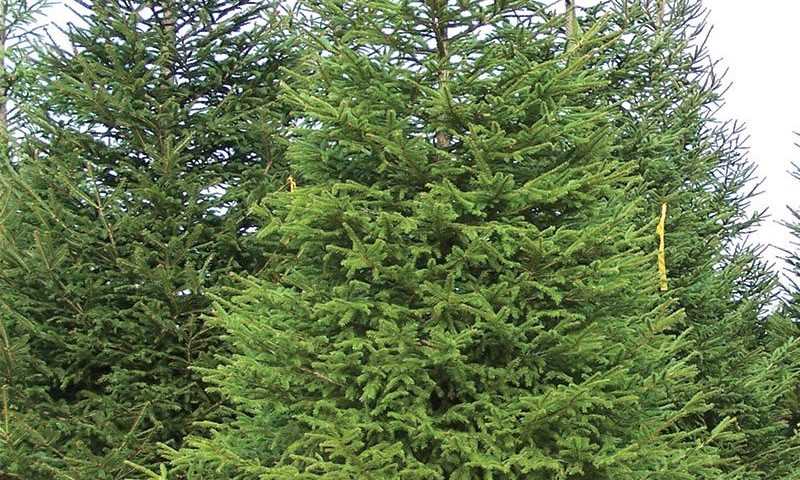
Prune the spruce tree as needed to maintain its shape and remove any dead or damaged branches. Pruning is best done in late winter or early spring before new growth begins.
Fertilizing
Spruce trees usually don’t require regular fertilization. However, if the tree is showing signs of nutrient deficiency, such as yellowing of the needles, you can apply a slow-release, balanced fertilizer in early spring.
Pest and Disease Control
Monitor the spruce tree for any signs of pests or diseases, such as spider mites, aphids, or needle cast. If necessary, consult a professional arborist or local extension office for appropriate pest and disease control measures.
Winter Care
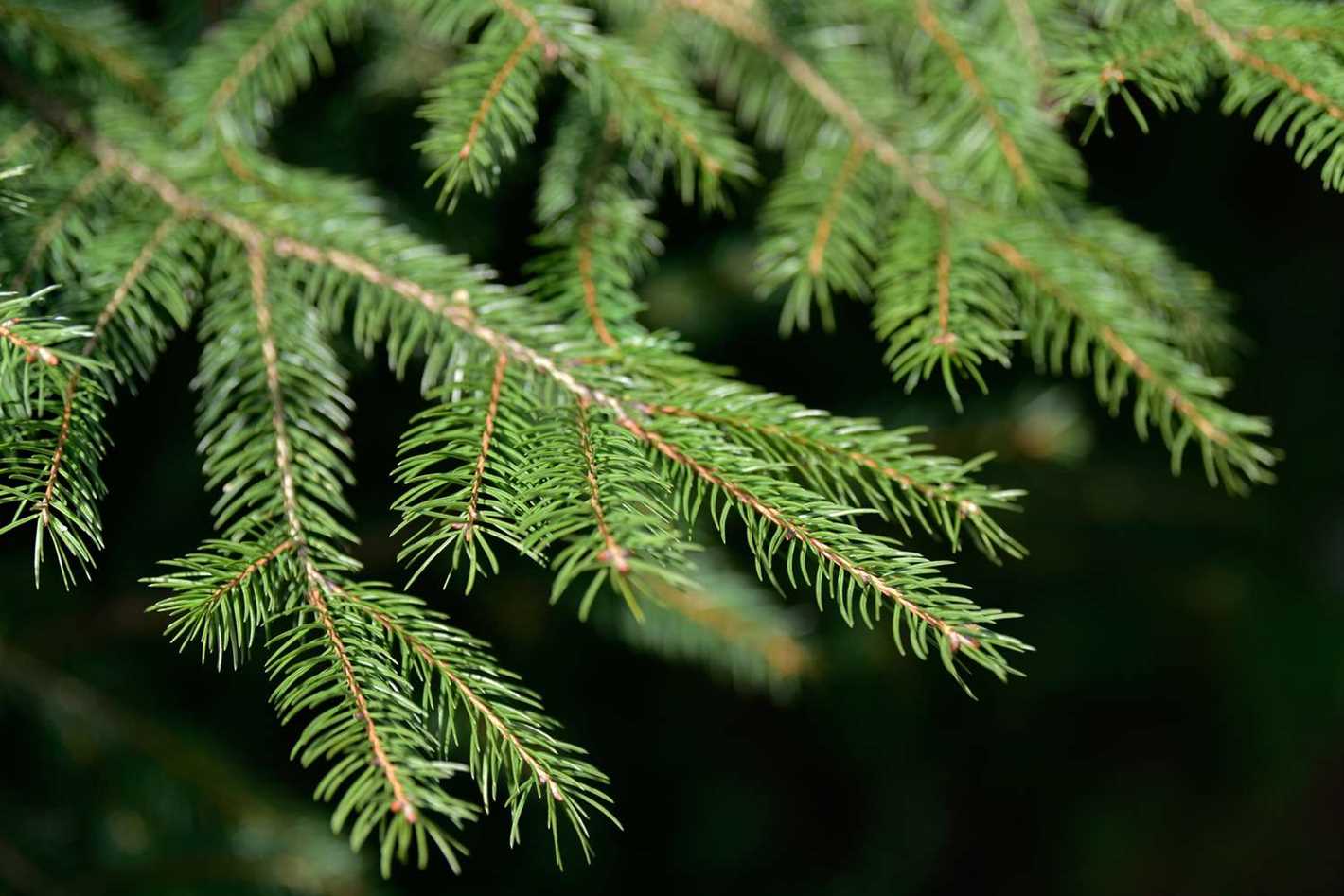
Some spruce tree species are sensitive to winter damage, especially when young. To protect the tree from harsh winter conditions, consider wrapping the trunk in burlap or applying a protective anti-desiccant spray.
Conclusion
With proper planting and care, spruce trees can thrive and provide beauty and shade in your landscape. Follow these guidelines to ensure the success of your spruce trees.
How to Plant Spruce Trees
Step 1: Choose the Right Location
Before planting a spruce tree, you need to select the right location. Spruce trees prefer full sun or partial shade and well-draining soil. Make sure the spot you choose has enough space for the tree to grow without being overcrowded by other plants or structures.
Step 2: Prepare the Planting Hole
Dig a hole that is two times wider and slightly deeper than the root ball of the spruce tree. This will give the roots room to spread and establish in the soil. Loosen the soil at the bottom of the hole to promote good drainage.
Step 3: Remove the Tree from the Container
Carefully remove the spruce tree from its container, gently loosening any roots that may be circling the inside of the pot. If the tree has a burlap or wire cage, remove it before planting.
Step 4: Place the Tree in the Hole
Set the spruce tree in the planting hole, making sure that the top of the root ball is level with or slightly above the surrounding soil. This will help prevent water from pooling around the trunk, which can lead to root rot.
Step 5: Backfill the Hole
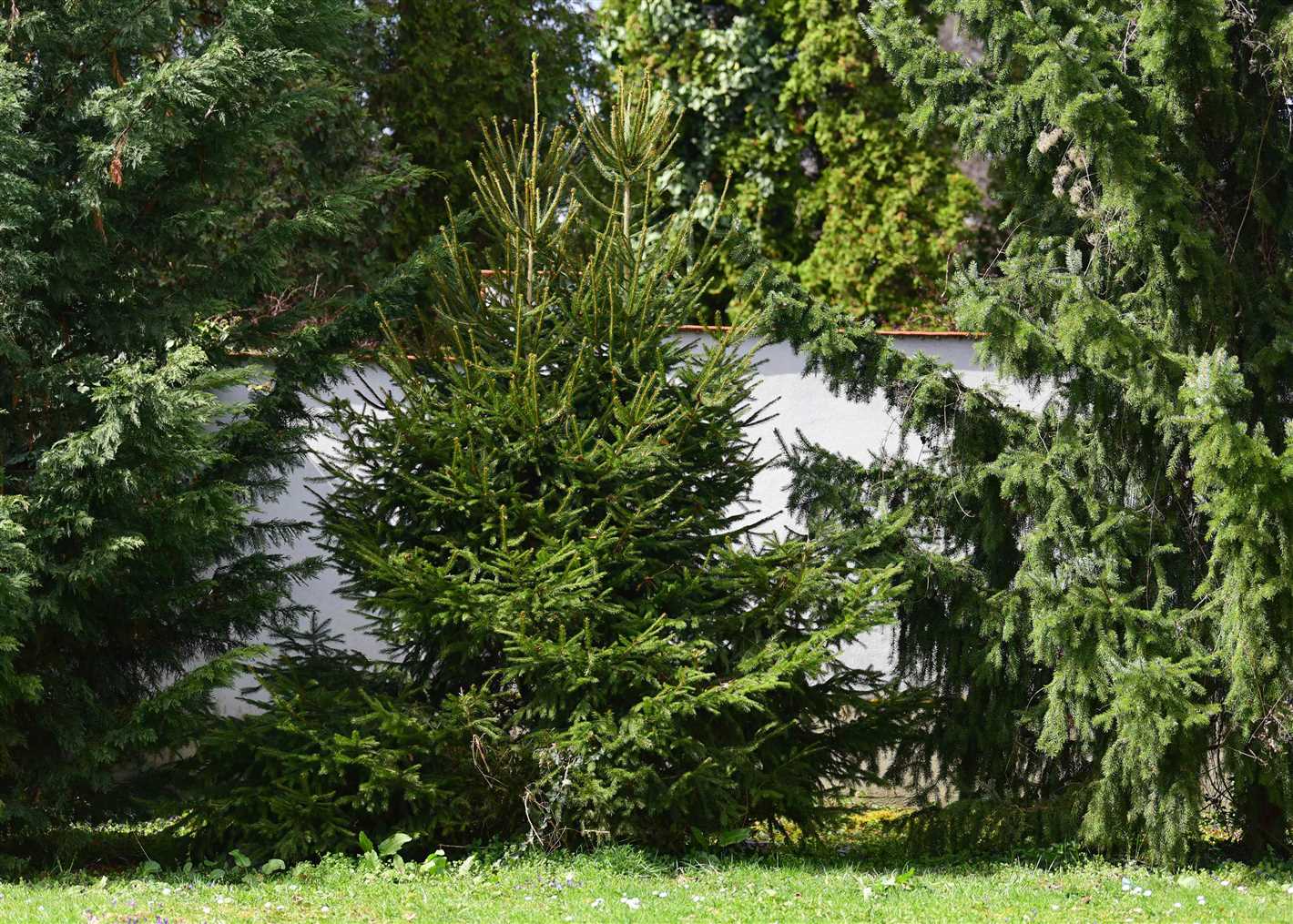
Fill the hole with a mixture of soil and organic matter, gently packing it around the roots to eliminate any air pockets. Water the tree thoroughly after backfilling to help settle the soil.
Step 6: Mulch Around the Tree
Apply a layer of mulch around the base of the spruce tree, extending it a few inches out from the trunk. This will help conserve moisture, suppress weeds, and regulate soil temperature.
Step 7: Water and Maintain
Water the newly planted spruce tree regularly, keeping the soil moist but not waterlogged. Monitor the tree for signs of stress or disease, and provide additional care as needed.
Following these steps will help ensure successful planting of spruce trees and promote healthy growth. Remember to choose the right location, prepare the planting hole properly, and provide proper care to help your spruce tree thrive.
Tips for Caring for Spruce Trees
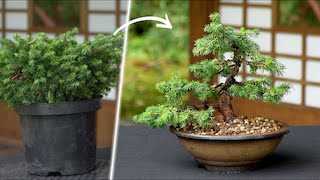
- Choose the right location: When planting a spruce tree, it’s important to select a location that provides enough sunlight and well-drained soil. Spruce trees prefer full sun to partial shade and thrive in moist, acidic soil.
- Watering: Newly planted spruce trees require regular watering during the first year to establish their root systems. Water deeply, providing enough moisture to reach the tree’s roots. Once established, spruce trees are more drought-tolerant but still benefit from supplemental irrigation during dry periods.
- Mulching: Apply a layer of organic mulch around the base of the tree, extending at least 3 feet from the trunk. Mulching helps regulate soil temperatures, conserve moisture, and control weed growth.
- Pruning: Prune spruce trees in late winter or early spring to remove any dead, damaged, or diseased branches. Avoid heavy pruning, as spruce trees have a naturally conical shape. Light and selective pruning can help maintain the tree’s form and structure.
- Fertilizing: Fertilize spruce trees in early spring with a slow-release, balanced fertilizer. Follow the manufacturer’s instructions for application rates. Avoid excessive fertilization, as it can lead to weak and brittle branches.
- Pest and disease control: Monitor spruce trees for signs of pests or diseases, such as spider mites, aphids, or needle cast disease. Treat any issues promptly with appropriate insecticides or fungicides.
- Protection from harsh conditions: Protect newly planted or young spruce trees from harsh winter conditions by wrapping them with burlap or applying a windbreak. This can help prevent damage from desiccation or heavy snow loads.
- Regular inspection: Regularly inspect your spruce trees for signs of stress, damage, or any changes in appearance. Promptly address any issues to ensure the health and longevity of the tree.
Spruce: Propagation
There are several ways to propagate spruce trees, including through seeds, cuttings, and grafting.
1. Propagation Through Seeds
To propagate spruce trees through seeds, you need to collect ripe cones from a healthy parent tree. The cones should be collected in late summer or early fall when they are fully mature and have turned brown.
Next, you need to extract the seeds from the cones. This can be done by placing the cones in a bag and gently crushing them to release the seeds. Remove any debris or winged structures from the seeds.
Once you have clean seeds, you can sow them immediately or store them in a cool, dry place until the following spring. To sow the seeds, create a seed bed in a well-draining soil mix and place the seeds on the surface. Lightly cover them with a thin layer of soil and keep the seed bed moist.
It usually takes several weeks for spruce seeds to germinate. Once they have germinated, you can transplant the seedlings to individual pots or directly into the ground.
2. Propagation Through Cuttings
Propagation through cuttings is another method commonly used for spruce trees. Select healthy, young branches from the desired parent tree and cut them into 4- to 6-inch long cuttings.
Remove the lower needles from the cuttings and dip the bottom ends in a rooting hormone powder. Then, plant the cuttings in a well-draining potting mix, ensuring that at least two-thirds of the cutting is buried in the soil.
Water the cuttings well and place them in a sheltered location with indirect sunlight. Keep the soil moist but not soggy, and mist the cuttings regularly to maintain humidity.
The cuttings will gradually develop roots, and once they are well-established, you can transplant them to individual pots or directly into the ground.
3. Propagation Through Grafting
Grafting is a more advanced method of propagation that is often used to reproduce specific varieties of spruce trees. It involves joining a desired scion (a piece of a desired tree) with a compatible rootstock (a seedling or root system of a different tree).
To graft a spruce tree, you need to make a clean cut on both the scion and the rootstock. The cuts should be made at a slight angle, and the cambium layers of both pieces should align to ensure successful grafting.
Join the scion and the rootstock together, securing them with grafting tape or grafting wax. Keep the graft union protected from excessive moisture and direct sunlight during the healing process.
After a few weeks, the graft union should heal and the scion will start growing. Monitor the growth and remove any shoots that develop below the graft union.
Grafted spruce trees can be transplanted into the ground once they have reached a suitable size and have established a strong root system.
Propagation of spruce trees can be a rewarding process, allowing you to create new trees with desirable traits. Whether you choose to propagate through seeds, cuttings, or grafting, ensure that you provide the appropriate care and conditions for successful propagation.
Methods of Propagating Spruce Trees
Spruce trees can be propagated using various methods, such as seeds, cuttings, and grafting. Each method has its advantages and disadvantages, and the best choice depends on the specific circumstances and goals of the propagation.
1. Seed Propagation
Seed propagation is the most common method used to propagate spruce trees. This method involves collecting seeds from mature cones and sowing them in a suitable growing medium. The seeds require a period of cold stratification before they can germinate, which can be achieved by storing them in a refrigerator for several weeks.
Here are the steps to propagate spruce trees from seeds:
- Collect mature cones and extract the seeds.
- Place the seeds in a plastic bag with a moist growing medium.
- Store the bag in a refrigerator for the required cold stratification period.
- Take the seeds out of the refrigerator and sow them in a seed tray or individual pots.
- Keep the seeds moist and provide them with sufficient light.
- Transplant the seedlings into larger containers or directly into the ground when they are large enough.
2. Cutting Propagation
Propagation through cuttings involves taking a portion of a spruce tree and encouraging it to develop roots and grow into a new tree. Softwood cuttings and hardwood cuttings are the two primary types of cuttings used to propagate spruce trees.
Here is a general process to propagate spruce trees from cuttings:
- Select a healthy branch from a mature spruce tree.
- Cut a 4-6 inch portion of the branch, ensuring it has a few pairs of healthy needles.
- Remove the lower needles from the cutting.
- Dip the cut end of the cutting into rooting hormone.
- Plant the cutting in a container with a well-draining growing medium.
- Place the container in a shaded area and keep the soil consistently moist.
- Monitor the cutting for signs of root development, such as new growth or resistance when gently tugged.
- Transplant the rooted cutting into a larger container or directly into the ground when it has established sufficient roots.
3. Grafting
Grafting is a more advanced method of propagating spruce trees, commonly used in commercial nurseries or for specific cultivars. This method involves joining a scion, which is a detached shoot of the desired spruce variety, with a rootstock of a different spruce variety, resulting in a new tree with desirable traits.
The process of grafting spruce trees typically involves the following steps:
- Select a healthy rootstock spruce tree and a scion from the desired variety.
- Cut both the rootstock and scion at an angle.
- Join the two pieces together, ensuring their cambium layers align.
- Secure the graft with grafting tape or grafting wax.
- Place the grafted spruce tree in a protected environment, such as a greenhouse or high-humidity chamber.
- Monitor the graft for signs of successful integration, such as new growth from the scion.
- Gradually expose the grafted spruce tree to outdoor conditions once it has established.
Whichever propagation method is chosen, it’s important to provide adequate care and maintenance to ensure the successful establishment and growth of the propagated spruce trees.
Best Time to Propagate Spruce Trees
Introduction
Propagating spruce trees can be a rewarding endeavor for both beginner and experienced gardeners. By propagating spruce trees, you can create new plants and expand your collection without having to spend money on buying new ones. However, timing is crucial when it comes to propagating spruce trees. In this section, we will explore the best time to propagate spruce trees for optimal success.
Method 1: Propagation from Seeds
The best time to propagate spruce trees from seeds is in the late winter or early spring, usually around February or March. During this time, the seeds are naturally primed for germination and have a higher chance of success. It is important to note that spruce seeds have a short viability period, so it is best to collect fresh seeds or purchase them from a reputable source.
Method 2: Propagation from Cuttings
Propagating spruce trees from cuttings is another popular method. The best time to take cuttings for spruce propagation is in early summer, typically in June or July. During this time, the trees are actively growing, and the cuttings have a better chance of rooting successfully. It is important to select healthy, disease-free branches for the best results.
Method 3: Propagation by Division
Propagation by division involves separating an existing spruce tree into multiple plants. This method is typically done in the early spring or late fall when the tree is dormant. It is important to dig up the tree carefully, ensuring that each division has enough roots to sustain itself. Dividing spruce trees when they are dormant helps minimize stress on the plants.
Conclusion
Knowing the best time to propagate spruce trees is essential for successful propagation. Whether you choose to grow from seeds, cuttings, or division, timing plays a crucial role in ensuring the success of your new plants. By following the recommended timing guidelines outlined in this article, you can increase your chances of successful spruce tree propagation.
Spruce: Species
Spruce is a genus of coniferous evergreen trees that belong to the family Pinaceae. There are several species of spruce, each with its own unique characteristics and growing requirements. Here are some of the most common species of spruce:
1. Norway Spruce (Picea abies)
The Norway spruce is one of the most common species of spruce and is native to Europe. It is a large tree that can reach heights of up to 60 meters. The needles of the Norway spruce are dark green and are about 1-2 centimeters long. This species is known for its fast growth and is commonly used for timber production.
2. Colorado Spruce (Picea pungens)
The Colorado spruce, also known as the blue spruce, is native to the Rocky Mountains in North America. It is a medium to large-sized tree with a conical shape and blue-green needles. The Colorado spruce is often grown as an ornamental tree in gardens and parks due to its attractive color and shape.
3. White Spruce (Picea glauca)
The white spruce, also known as the Canadian spruce, is native to North America. It is a medium-sized tree that can reach heights of up to 30 meters. The needles of the white spruce are blue-green in color and have a strong aroma. This species is commonly used for reforestation and as a windbreak tree.
4. Black Spruce (Picea mariana)
The black spruce is native to the northern parts of North America, including Canada and Alaska. It is a small to medium-sized tree that grows in wetlands and peat bogs. The black spruce has dark green needles and can tolerate cold and wet conditions. It is an important tree for wildlife habitat and is commonly used for pulpwood and timber production.
5. Sitka Spruce (Picea sitchensis)
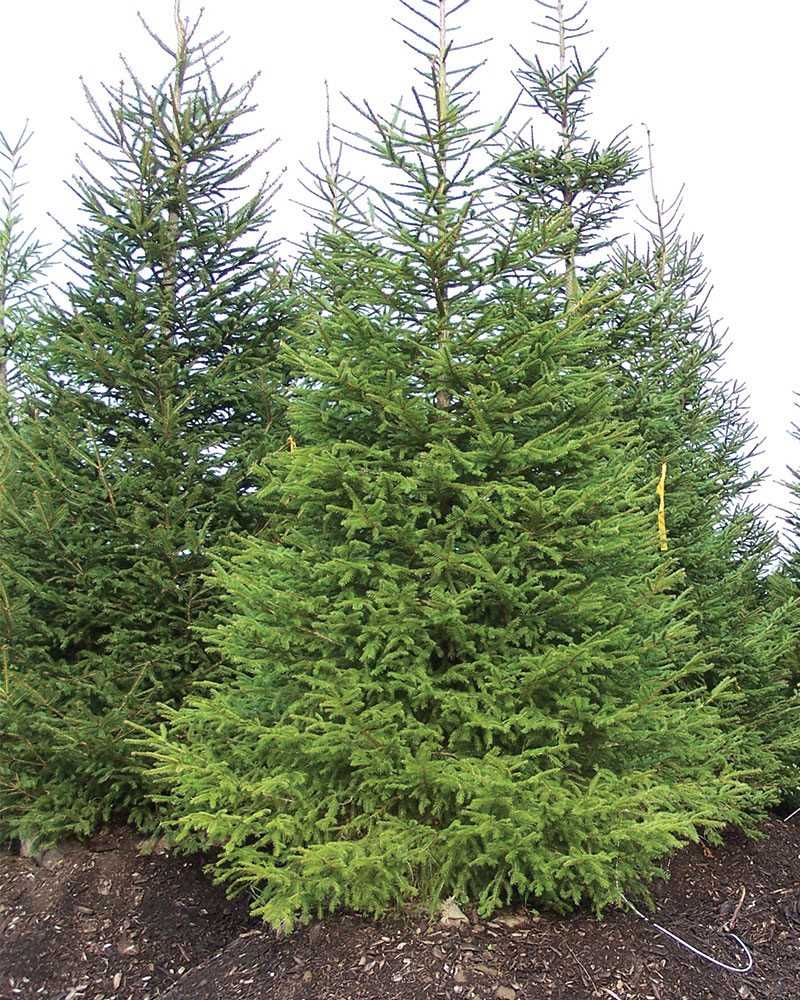
The Sitka spruce is native to the west coast of North America, particularly in Alaska and British Columbia. It is a large tree that can reach heights of up to 90 meters, making it one of the tallest spruce species. The needles of the Sitka spruce are dark green and have a sharp texture. This species is widely used for timber production and is known for its high-quality wood.
These are just a few examples of the many species of spruce that exist. Each species has its own unique characteristics and can be suitable for different growing conditions and purposes. When choosing a spruce species, it is important to consider factors such as climate, soil conditions, and intended use.
Different Species of Spruce Trees
- Norway Spruce (Picea abies): This is one of the most common species of spruce trees. It has a dense, pyramidal shape and is known for its dark green needles.
- White Spruce (Picea glauca): The white spruce is native to North America and is known for its silver-blue foliage. It is a popular choice for landscaping and can tolerate cold climates.
- Colorado Spruce (Picea pungens): This spruce tree is native to the Rocky Mountains in the United States. It has a distinctive silver-blue color and is often used as a specimen or accent tree.
- Black Spruce (Picea mariana): The black spruce is a native of North America and is known for its ability to grow in wet or swampy areas. It has short, dark green needles and is often used in reforestation projects.
The spruce tree is a popular choice for landscaping due to its attractive shape and foliage. It is also commonly used for Christmas trees due to its symmetrical form and ability to hold ornaments. With their variety of species, spruce trees offer options for different climates and aesthetics. Whether you prefer the classic Norway spruce or the unique color of the Colorado spruce, there is a species of spruce tree to suit your needs.
Characteristics of Spruce Tree Species
Spruce trees belong to the genus Picea, which is part of the family Pinaceae. There are various species of spruce trees, each with its own unique characteristics. Here are some general characteristics of spruce tree species:
- Spruce trees are coniferous, evergreen trees that can reach heights of up to 60 meters.
- They have a straight, narrow trunk with branches that extend horizontally.
- Their bark is thin, smooth, and grayish-brown in color.
- Their needles are needle-like and are arranged spirally around the branches. They are usually sharp and have a pointed tip.
- The needles are dark green in color on the upper surface and lighter green on the underside.
- Spruce trees produce cones that are pendulous and are usually small in size.
- The cones mature in one season and disintegrate before releasing their seeds.
- Spruce trees have shallow, spreading root systems that provide stability in windy conditions.
- They prefer cool climates and can tolerate harsh winter conditions.
- Some common species of spruce trees include Norway spruce, Colorado blue spruce, and white spruce.
Spruce trees are known for their beauty and are often used as ornamental trees in parks and gardens. They also have commercial value as timber trees and are commonly used for construction, pulpwood, and furniture making due to their strong and durable wood.
Questions and Answers:
How do I plant a spruce tree?
Planting a spruce tree requires choosing the right location, preparing the soil, digging a hole, placing the tree in the hole, backfilling with soil, and watering thoroughly.
What are some common species of spruce trees?
Some common species of spruce trees include Norway spruce, Colorado spruce, white spruce, black spruce, and blue spruce.
What are the ideal growing conditions for spruce trees?
Spruce trees thrive in full sun to partial shade and prefer moist, well-drained soil. They also prefer acidic soil with a pH range of 4.5 to 6.0.
How often should I water my spruce tree?
During the first year, it’s important to water your spruce tree regularly, especially during dry spells. Water deeply once or twice a week, ensuring the soil is moist but not waterlogged.
When is the best time to prune a spruce tree?
The best time to prune a spruce tree is in late winter or early spring, before new growth starts. This helps to promote healthy growth and shape the tree.
Can I propagate spruce trees from cuttings?
Yes, it is possible to propagate spruce trees from cuttings. Take semi-hardwood cuttings in late summer or early fall and root them in a well-draining rooting medium.







